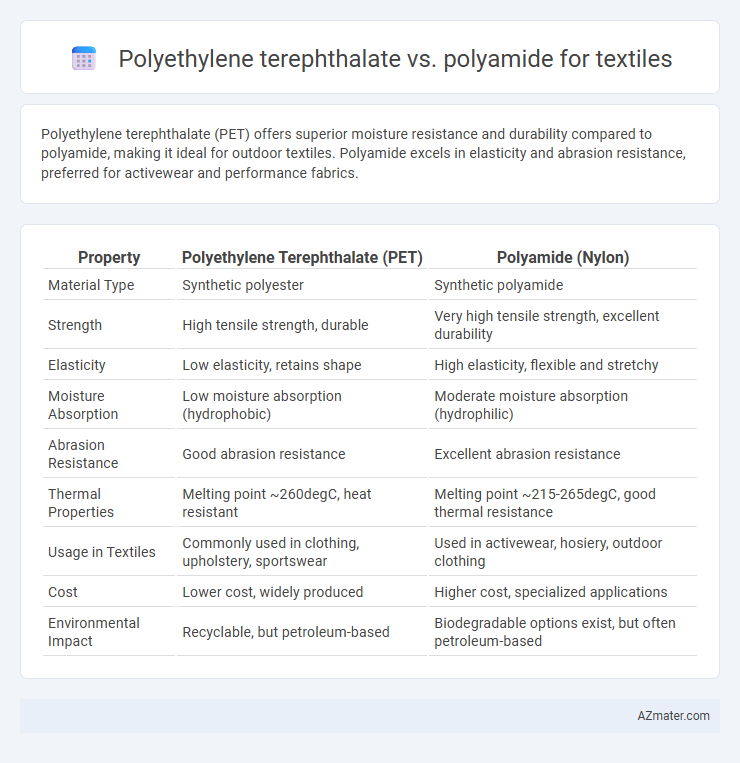Polyethylene terephthalate (PET) offers superior moisture resistance and durability compared to polyamide, making it ideal for outdoor textiles. Polyamide excels in elasticity and abrasion resistance, preferred for activewear and performance fabrics.
Table of Comparison
| Property | Polyethylene Terephthalate (PET) | Polyamide (Nylon) |
|---|---|---|
| Material Type | Synthetic polyester | Synthetic polyamide |
| Strength | High tensile strength, durable | Very high tensile strength, excellent durability |
| Elasticity | Low elasticity, retains shape | High elasticity, flexible and stretchy |
| Moisture Absorption | Low moisture absorption (hydrophobic) | Moderate moisture absorption (hydrophilic) |
| Abrasion Resistance | Good abrasion resistance | Excellent abrasion resistance |
| Thermal Properties | Melting point ~260degC, heat resistant | Melting point ~215-265degC, good thermal resistance |
| Usage in Textiles | Commonly used in clothing, upholstery, sportswear | Used in activewear, hosiery, outdoor clothing |
| Cost | Lower cost, widely produced | Higher cost, specialized applications |
| Environmental Impact | Recyclable, but petroleum-based | Biodegradable options exist, but often petroleum-based |
Introduction to Polyethylene Terephthalate and Polyamide
Polyethylene terephthalate (PET) is a widely used synthetic polymer in textiles known for its high strength, durability, and resistance to environmental factors like moisture and UV radiation. Polyamide, commonly referred to as nylon, offers excellent elasticity, abrasion resistance, and moisture-wicking properties, making it ideal for activewear and technical fabrics. Both polymers serve distinct purposes in textile applications, with PET favored for its stability and polyamide valued for flexibility and comfort.
Chemical Structure and Composition
Polyethylene terephthalate (PET) is a polyester composed of repeating units of ethylene glycol and terephthalic acid, characterized by its ester functional groups that confer high tensile strength and excellent resistance to moisture and chemicals. Polyamide, commonly known as nylon, consists of repeating amide linkages formed from diamine and dicarboxylic acid monomers, offering superior elasticity, abrasion resistance, and thermal stability. The distinct chemical structures--ester linkages in PET versus amide bonds in polyamide--directly influence their respective properties and applications in textile manufacturing.
Manufacturing Processes Compared
Polyethylene terephthalate (PET) manufacturing involves a melt-spinning process where polymer chips are melted and extruded into filaments, allowing high-speed production with consistent fiber strength and dimensional stability. In contrast, polyamide (nylon) production uses a solution-spinning method that dissolves the polymer prior to extrusion, resulting in fibers with superior elasticity and moisture absorption but requiring more complex solvent recovery systems. PET offers cost-effective, energy-efficient mass production with excellent durability, while polyamide demands higher processing precision and investment for specialized textile applications emphasizing flexibility and abrasion resistance.
Mechanical Properties and Strength
Polyethylene terephthalate (PET) exhibits high tensile strength and excellent abrasion resistance, making it ideal for durable textile applications. Polyamide (nylon) offers superior elasticity and impact resistance due to its higher elongation at break and toughness, which enhances flexibility under load. While PET maintains dimensional stability and resistance to environmental factors, polyamide excels in mechanical resilience and strain recovery.
Moisture Absorption and Comfort
Polyamide fibers exhibit superior moisture absorption compared to Polyethylene Terephthalate (PET), with polyamide absorbing up to 4% of its weight in water, enhancing wearer comfort by efficiently wicking sweat away from the skin. Polyethylene Terephthalate, known for its low moisture regain of about 0.4%, tends to retain less water, making fabrics made from PET less breathable but quicker drying. The choice between PET and polyamide in textiles significantly impacts comfort, with polyamide preferred for applications requiring higher moisture management and PET favored for durability and quick-drying properties.
Durability and Longevity in Textiles
Polyethylene terephthalate (PET) offers exceptional durability and resistance to abrasion, making it ideal for high-wear textiles such as activewear and upholstery. Polyamide textiles, commonly known as nylon, provide superior tensile strength and elasticity, enhancing their longevity in applications requiring flexibility and shape retention. Both fibers resist chemical and environmental degradation, but PET generally outperforms polyamide in UV resistance, contributing to longer-lasting textile products exposed to sunlight.
Dyeability and Colorfastness
Polyethylene terephthalate (PET) exhibits lower dyeability compared to polyamide due to its hydrophobic nature and high crystallinity, requiring disperse dyes and high-temperature dyeing processes. Polyamide fibers, such as nylon, offer superior dye affinity and brighter color absorption because of their polar amide groups that readily interact with acid dyes. In terms of colorfastness, polyamide generally provides excellent light and wash fastness, while PET fibers often demonstrate greater resistance to environmental degradation and chemical exposure.
Environmental Impact and Sustainability
Polyethylene terephthalate (PET) offers significant environmental advantages over polyamide due to its higher recyclability and lower carbon footprint during production. While PET fibers can be efficiently recycled into new textiles, reducing landfill waste and resource consumption, polyamide's production involves more energy-intensive processes and greater greenhouse gas emissions. Choosing PET supports sustainable textile manufacturing by minimizing environmental impact and promoting circular economy principles.
Cost Considerations for Textile Production
Polyethylene terephthalate (PET) is generally more cost-effective than polyamide (nylon) in textile production due to its lower raw material prices and energy-efficient manufacturing process. Polyamide typically incurs higher expenses because of more complex polymerization and finishing techniques required to achieve desired fabric properties. Choosing PET can reduce overall production costs while still providing adequate durability and moisture resistance for many textile applications.
Applications and End-Uses in the Textile Industry
Polyethylene terephthalate (PET) is widely used in technical textiles and apparel due to its high tensile strength, wrinkle resistance, and moisture-wicking properties, making it ideal for sportswear, upholstery, and industrial fabrics. Polyamide (nylon) offers superior elasticity, abrasion resistance, and durability, which suits it for applications like hosiery, swimwear, and activewear where stretch and resilience are critical. Both fibers are prominent in the textile industry, with PET favored for durability and cost-effectiveness, while polyamide is chosen for performance textiles requiring flexibility and toughness.

Infographic: Polyethylene terephthalate vs Polyamide for Textile
 azmater.com
azmater.com